► The alternative to EVs
► They use electricity but store it differently
► The pros and cons in 2023
Battery-powered fully-electric and hybrid cars are the standard-bearers for green vehicles set to supersede the internal combustion engine. But there’s a third option that often gets overlooked: hydrogen-powered cars.
Hydrogen has been used to fuel vehicles for decades; way back in 1807, Francois Isaac de Rivaz designed the first hydrogen-fuelled internal combustion engine, and century and a half later, scientist Roger Billings converted the engine of a Ford Model A to run on hydrogen. Fast forward a little, and today hydrogen is being used to send NASA rockets into space.
Now in 2023, there’s a suite of vehicles running on hydrogen; from London buses and forklift trucks, to the Toyota Mirai and the Hyundai Nexo.
Hydrogen cars haven’t exactly taken the world by storm, but they do offer a greener substitute to petrol and a possible alternative to battery-powered EVs.
How does a hydrogen car actually work?
Hydrogen can be used to fuel cars in two ways. The first is through hydrogen fuel cells, which work in a similar fashion to Lithium-ion battery EVs.
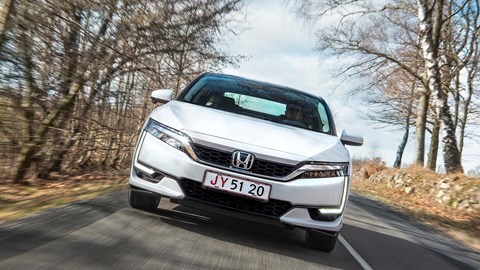
However, while the energy in batteries is stored via a chemical reaction, the energy in hydrogen cells is stored in hydrogen gas.
Hydrogen gas is stored in a tank which feeds fuel cells, each made up of negative and positive terminals (anodes and cathodes) separated by an electrolyte. Oxygen is taken from the air and pumped into the cathode, while hydrogen flows to the platinum anode terminal that acts as a catalyst, splitting positive hydrogen ions from the gas.
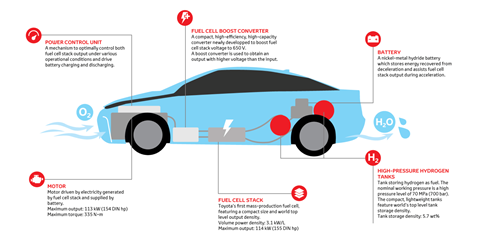
These ions flow through the electrolyte to the cathode to build a positive charge. As the separated electrons cannot flow through the electrolyte, they flow around an external circuit, generating a charge used to power an electric motor.
And what about emissions? As the hydrogen ions come into contact with the cathode, they combine with the oxygen to produce water that then flows out of the car’s exhaust; it’s so pure you could drink it.
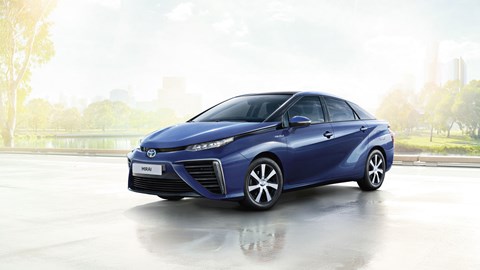
Using hydrogen for combustion
Hydrogen can also be used as a direct replacement for petrol or diesel in a specialised or converted internal combustion engine. In this case, pressurised hydrogen gas is directly injected into an engine’s combustion chamber and combustion takes place like a normal ICE.
Using hydrogen like this isn’t common, as it’s not as energy dense as petrol. But burning hydrogen does produce less emissions, with water as the main by-prioduce, and fewer toxic NOx gases coming from heat produced by the engine.
Like most cutting-edge technologies, it’s also been raced: a Aston Martin Rapide S fitted with a hybrid hydrogen engine by specialists Alset contested the N24, with the car able to switch between petrol or hydrogen fuel. Additionally, the Mazda RX-8 Hydrogen RE, first revealed in 2003 was another hydrogen bi-fuel ICE car, but it was discontinued in 2011.
What are the advantages?
The most obvious advantage of hydrogen fuel, at least when it comes to fuel cell electric vehicles (FCEVs), is the lack emissions and harmful byproducts hydrogen-powered cars produce.
And as fuel cells don’t degrade like lithium-ion batteries, they tend to last a car’s lifetime – think some 150,000 miles. They can also be recycled, making them a pretty green option.
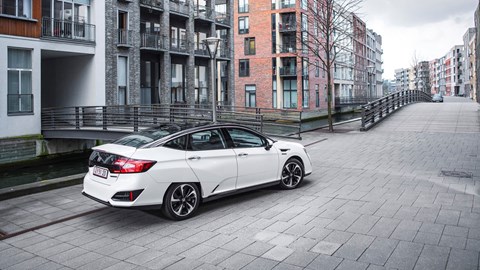
The range of FCEVs beats even the best EVs, with the small Toyota Mirai able to manage 300 miles on a single tank, with larger hydrogen cars like the Hyundai Nexo manage 400 miles.
When it comes to filling up the tank, it’s as easy as filling up a car with petrol. Hydrogen gas can simply be pumped into the tank ready to be sucked into the fuel cells; there’s no lengthy battery charging. But there are some key problems.
What are the disadvantages?
There are precious few places to fill up FCEVs. There’s virtually no hydrogen filling infrastructure in the UK, with less than 20 fuelling stations across Britain.
EVs might take longer to charge and still come with range anxiety, but at least they can be charged from a basic power socket, which compensates for a lack of widespread rapid charging points. And even then, the EV charging network are growing at a rapid rate, as is the speed of charging.
Most FCEVs come with a small battery to power them for short hops, but that still doesn’t overcome the problem of finding somewhere to fill up.
Carrying hydrogen is also tricky as it’s highly flammable. To prevent hydrogen cars from becoming automotive Hindembergs, the tanks holding the pressurised gas need to be extremely tough and crash resistant, making them more complex to engineer than petrol tanks. For the same reason, it’s also difficult to transport hydrogen to fueling stations, by tanker or pipeline.
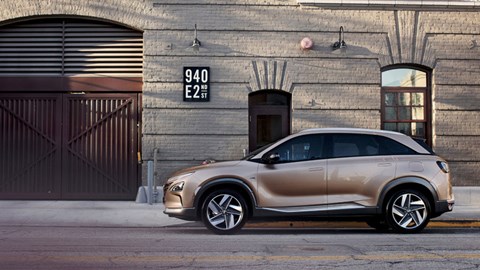
The other major problem is the production of hydrogen for fuel. It’s fairly easy to make by running an electrical current through water, which separates the hydrogen from the oxygen.
But that involves consuming electrical energy, most likely generated by burning fossil fuels, which means hydrogen isn’t that green on the production side. There’s an argument that solar power could be used to generate such electricity, but then that energy might as well be used to directly fill up a battery than generate another fuel.
Currently, mass production of hydrogen involves a process called steam methane reformation. In a nutshell, this involves getting hydrogen from methane natural gas through an exothermic reaction.
But as this involves burning a fossil fuel, it’s not exactly a green way to produce hydrogen. Overall, it’s a cleaner fuel than petrol, but not as clean as electricity generated from renewable sources.
Scientists are working on making hydrogen production cleaner but until they can do that at scale, you’re not likely to see many hydrogen fuel pumps at roadside stations.
Cost is also a factor: hydrogen is expensive, costing more per kilogram and per mile than petrol. And given hydrogen is not as energy dense, you’ll likely need to refuel more often.
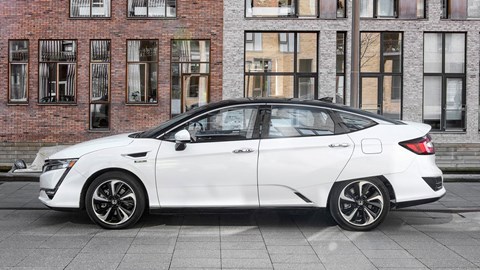
Is there a future for hydrogen cars?
It’s a classic chicken and egg situation; hydrogen fueling points are only likely to increase if there are more FCEVs, and such cars are only going to be popular if there are places to fuel them.
As of 2023, hydrogen cars are still far from the mainstream. Improvements in EV range, battery endurance, and charging infrastructure – alongside massive investment for major car brands – mean the momentum isn’t with FCEVs. And advancements like the development of solid-state batteries and the use of supercapacitors keep charging EVs forward.
However, more and more manufacturers are showing an interest in hydrogen fuel technology, with BMW, Toyota and Hyundai all having brandished their early understandings of hydrogen power in a few concept cars. Extensive hydrogen fuel testing is underway, but the hydrogen-powered vehicle market is expected to take off by around 2028, according to a market study.
Seth Walton is a staff writer on Bauer’s digital automotive hub. He specializes in motoring advice and other ownership content for CAR and Parkers, but has also taken to car accessory reviews as a former member of the Bauer affiliate team. He enjoys historic racing and has an affinity with old Ferraris, though he doesn’t care much for those who drive them.